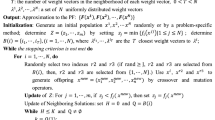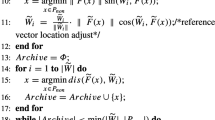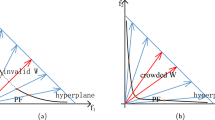Abstract
Decomposition-based evolutionary algorithms have shown great potential in solving many-objective optimization problems (MaOPs). However, manual parameters (e.g., neighbor size and scalarizing function) and the specified weight vector can easily degrade the performance of the algorithm, especially for MaOPs with irregular Pareto fronts. This paper presents a new decomposition-based evolutionary algorithm that adopts a bi-layer decision strategy to balance convergence and diversity of solutions for MaOPs, and it is free from neighborhood update and scalarizing methods. In the first layer decision, the well-converged solutions in each subregion form a primary population, where an adaptive fitness assignment considering the Pareto front shape is used to accelerate convergence. In the second layer decision, solutions in the primary population are ranked based on the diversity metric. The low-ranking solutions are added to the final population size until the population size is met. Further, to approximate the true PF as soon as possible, the intensity of convergence in the first layer decision and the activation frequency of the re-balance strategy are regulated. Moreover, we design a re-balance selection strategy to alleviate the dilemma of the specified weight vectors. The re-balance selection uses a clustering approach to adjust weight vectors to promote the uniform distribution of solutions. Finally, algorithms are verified on 150 test instances and one practical design problem. The experimental results show that the proposed algorithm performs better than five state-of-the-art peer algorithms on at least 64% test instances concerning hypervolume and has superiority over competitors on at least 72% test instances concerning the inverted generational distance plus.









Similar content being viewed by others
Notes
Subproblems are determined by weight vectors, and each of them only optimizes the corresponding direction. The subregion is divided by weight vectors, and it decomposes the objective space.
References
Tirkolaee EB, Goli A, Faridnia A, Soltani M, Weber GW (2020) Multi-objective optimization for the reliable pollution-routing problem with cross-dock selection using pareto-based algorithms. J Clean Prod 276(122):927. https://doi.org/10.1016/j.jclepro.2020.122927
Tirkolaee EB, Goli A, Weber GW (2020) Fuzzy mathematical programming and self-adaptive artificial fish swarm algorithm for just-in-time energy-aware flow shop scheduling problem with outsourcing option. IEEE Trans Fuzzy Syst 28(11):2772–2783. https://doi.org/10.1109/TFUZZ.2020.2998174
Tirkolaee EB, Mardani A, Dashtian Z, Soltani M, Weber GW (2020) A novel hybrid method using fuzzy decision making and multi-objective programming for sustainable-reliable supplier selection in two-echelon supply chain design. J Clean Prod 250(119):517. https://doi.org/10.1016/j.jclepro.2019.119517
Li B, Li J, Tang K, Yao X (2015) Many-objective evolutionary algorithms: a survey. ACM Computing Surveys (CSUR) 48(1):1–35
Chen L, Liu HL, Tan KC, Cheung YM, Wang Y (2019) Evolutionary many-objective algorithm using decomposition-based dominance relationship. IEEE Trans Cybern 49(12):4129–4139. https://doi.org/10.1109/tcyb.2018.2859171
Deb K, Pratap A, Agarwal S, Meyarivan T (2002) A fast and elitist multiobjective genetic algorithm: NSGA-II. IEEE Trans Evol Comput 6(2):182–197. https://doi.org/10.1109/4235.996017
Zitzler E, Laumanns M, Thiele L (2001) Spea2: Improving the strength pareto evolutionary algorithm. TIK-report 103
Li M, Yang S, Liu X (2014) Shift-based density estimation for pareto-based algorithms in many-objective optimization. IEEE Trans Evol Comput 18(3):348–365. https://doi.org/10.1109/tevc.2013.2262178
Li M, Yang S, Liu X (2015) Bi-goal evolution for many-objective optimization problems. Artif Intell 228:45–65. https://doi.org/10.1016/j.artint.2015.06.007
Laumanns M, Thiele L, Deb K, Zitzler E (2002) Combining convergence and diversity in evolutionary multiobjective optimization. Evolutionary Ccomputation 10(3):263–282. https://doi.org/10.1162/106365602760234108
Farina M, Amato P (2004) A fuzzy definition of “optimality” for many-criteria optimization problems. IEEE Trans Syst Man Cybern-Part A Syst Humans 34(3):315–326. https://doi.org/10.1109/TSMCA.2004.824873
Liu Y, Zhu N, Li K, Li M, Zheng J, Li K (2020) An angle dominance criterion for evolutionary many-objective optimization. Inf Sci 509:376–399. https://doi.org/10.1016/j.ins.2018.12.078
Liu Y, Zhu N, Li M (2021) Solving many-objective optimization problems by a pareto-based evolutionary algorithm with preprocessing and a penalty mechanism. IEEE Trans Cybern 51(11):5585–5594. https://doi.org/10.1109/TCYB.2020.2988896
Wagner T, Beume N, Naujoks B (2007) Pareto-, aggregation-, and indicator-based methods in many-objective optimization. In: International conference on evolutionary multi-criterion optimization. Springer, pp 742–756
Adra SF, Fleming PJ (2010) Diversity management in evolutionary many-objective optimization. IEEE Trans Evol Comput 15(2):183–195. https://doi.org/10.1109/TEVC.2010.2058117
Zitzler E, Künzli S (2004) Indicator-based selection in multiobjective search. In: International conference on parallel problem solving from nature. Springer, pp 832–842
Brockhoff D, Wagner T, Trautmann H (2012) On the properties of the r2 indicator. In: Proceedings of the 14th annual conference on Genetic and evolutionary computation, pp 465–472
Bader J, Zitzler E (2011) Hype: an algorithm for fast hypervolume-based many-objective optimization. Evol Comput 19(1):45–76
Falcón-Cardona JG, Coello CAC (2020) Indicator-based multi-objective evolutionary algorithms: a comprehensive survey. ACM Computing Surveys (CSUR) 53(2):1–35. https://doi.org/10.1145/3376916
Sun Y, Yen GG, Yi Z (2019) IGD Indicator-based evolutionary algorithm for many-objective optimization problems. IEEE Trans Evol Comput 23(2):173–187. https://doi.org/10.1109/tevc.2018.2791283
Pamulapati T, Mallipeddi R (2019) Suganthan, P.N.: \({i_{\text {{{SDE}}}}}^{+}\)—an indicator for multi and many-objective optimization. IEEE Trans Evol Comput 23(2):346–352. https://doi.org/10.1109/TEVC.2018.2848921
Zhang Q, Li H (2007) Moea/d: a multiobjective evolutionary algorithm based on decomposition. IEEE Trans Evolution Comput 11(6):712–731
Deb K, Jain H (2014) An evolutionary many-objective optimization algorithm using reference-point-based nondominated sorting approach, part i: Solving problems with box constraints. IEEE Trans Evol Comput 18(4):577–601. https://doi.org/10.1109/TEVC.2013.2281535
Wang R, Zhang Q, Zhang T (2016) Decomposition-based algorithms using pareto adaptive scalarizing methods. IEEE Trans Evol Comput 20(6):821–837. https://doi.org/10.1109/tevc.2016.2521175
Chen L, Liu HL, Tan KC, Cheung YM, Wang Y (2018) Evolutionary many-objective algorithm using decomposition-based dominance relationship. IEEE Trans Cybern 49(12):4129–4139. https://doi.org/10.1109/TCYB.2018.2859171
Zhao C, Zhou Y, Chen Z (2021) Decomposition-based evolutionary algorithm with automatic estimation to handle many-objective optimization problem. Inf Sci 546:1030–1046. https://doi.org/10.1016/j.ins.2020.08.084
He X, Zhou Y, Chen Z, Zhang Q (2019) Evolutionary many-objective optimization based on dynamical decomposition. IEEE Trans Evol Comput 23(3):361–375. https://doi.org/10.1109/tevc.2018.2865590
Sun Y, Xue B, Zhang M, Yen GG (2019) A new two-stage evolutionary algorithm for many-objective optimization. IEEE Trans Evol Comput 23(5):748–761. https://doi.org/10.1109/tevc.2018.2882166
Liu Y, Ishibuchi H, Masuyama N, Nojima Y (2020) Adapting reference vectors and scalarizing functions by growing neural gas to handle irregular pareto fronts. IEEE Trans Evol Comput 1–1. https://doi.org/10.1109/tevc.2019.2926151
Cui Z, Chang Y, Zhang J, Cai X, Zhang W (2019) Improved nsga-iii with selection-and-elimination operator. Swarm Evolution Comput 49:23–33. https://doi.org/10.1016/j.swevo.2019.05.011
Xiang Y, Zhou Y, Yang X, Huang H (2020) A many-objective evolutionary algorithm with pareto-adaptive reference points. IEEE Trans Evol Comput 24(1):99–113. https://doi.org/10.1109/tevc.2019.2909636
Li M, Yang S, Liu X (2016) Pareto or non-pareto: Bi-criterion evolution in multiobjective optimization. IEEE Trans Evol Comput 20(5):645–665. https://doi.org/10.1109/tevc.2015.2504730
Ikeda K, Kita H, Kobayashi S (2001) Failure of pareto-based moeas: Does non-dominated really mean near to optimal?. In: Congress on evolutionary computation (IEEE cat. no. 01TH8546). https://doi.org/10.1109/CEC.2001.934293, vol 2. IEEE, pp 957–962
Von Luxburg U (2007) A tutorial on spectral clustering. Stat Comput 17(4):395–416. https://doi.org/10.1007/s11222-007-9033-z
Hartigan JA, Wong MA (1979) Algorithm as 136: a k-means clustering algorithm. J R Stat Soc Ser C (Appl Stat) 28(1):100–108. https://doi.org/10.2307/2346830
Das I, Dennis JE (1998) Normal-boundary intersection: a new method for generating the pareto surface in nonlinear multicriteria optimization problems. SIAM J Optim 8(3):631–657
Deb K (2014) Multi-objective optimization. In: Search methodologies. Springer, pp 403–449
Sato H (2014) Inverted pbi in moea/d and its impact on the search performance on multi and many-objective optimization. In: Proceedings of the 2014 annual conference on genetic and evolutionary computation, pp 645–652. https://doi.org/10.1145/2576768.2598297
Ishibuchi H, He L, Shang K (2019) Regular pareto front shape is not realistic. In: 2019 IEEE Congress on evolutionary computation (CEC). IEEE, pp 2034–2041. https://doi.org/10.1109/CEC.2019.8790342
Yan D, Huang L, Jordan MI (2009) Fast approximate spectral clustering. In: Proceedings of the 15th ACM SIGKDD international conference on Knowledge discovery and data mining, pp 907–916. https://doi.org/10.1109/CEC.2019.8790342
Deb K, Thiele L, Laumanns M, Zitzler E (2005) Scalable test problems for evolutionary multiobjective optimization. In: Evolutionary multiobjective optimization. Springer, pp 105–145
Ishibuchi H, Setoguchi Y, Masuda H, Nojima Y (2017) Performance of decomposition-based many-objective algorithms strongly depends on pareto front shapes. IEEE Trans Evol Comput 21 (2):169–190. https://doi.org/10.1109/tevc.2016.2587749
Huband S, Barone L, While L, Hingston P (2005) A scalable multi-objective test problem toolkit. In: International conference on evolutionary multi-criterion optimization. Springer, pp 280–295
Li H, Deb K, Zhang Q, Suganthan P, Chen L (2019) Comparison between moea/d and nsga-iii on a set of novel many and multi-objective benchmark problems with challenging difficulties. Swarm Evolution Comput 46:104–117. https://doi.org/10.1016/j.swevo.2019.02.003
Liao X, Li Q, Yang X, Zhang W, Li W (2008) Multiobjective optimization for crash safety design of vehicles using stepwise regression model. Struct Multidiscip Optim 35(6):561–569
Ishibuchi H, Masuda H, Nojima Y (2015) Pareto fronts of many-objective degenerate test problems. IEEE Trans Evol Comput 20(5):807–813. https://doi.org/10.1109/TEVC.2015.2505784
Deb K, Agrawal RB, et al. (1995) Simulated binary crossover for continuous search space. Complex Systems 9(2):115–148
Deb K, Goyal M (1996) A combined genetic adaptive search (geneas) for engineering design. Comput Sci Inform 26:30–45
Lopez EM, Coello CAC (2016) Igd+-emoa: a multi-objective evolutionary algorithm based on igd+. In: 2016 IEEE Congress on evolutionary computation (CEC). IEEE, pp 999–1006. https://doi.org/10.1109/CEC.2016.7743898
Wang H, Jin Y, Yao X (2017) Diversity assessment in many-objective optimization. IEEE Trans Cybern 47(6):1510–1522. https://doi.org/10.1109/tcyb.2016.2550502
Woolson R (2007) Wilcoxon signed-rank test. Wiley Encyclopedia of Clinical Trials 1–3. https://doi.org/10.1002/9780471462422.eoct979
Xiang Y, Zhou Y, Tang L, Chen Z (2017) A decomposition-based many-objective artificial bee colony algorithm. IEEE Trans Cybern 49(1):287–300. https://doi.org/10.1109/TCYB.2017.2772250
Ishibuchi H, Imada R, Setoguchi Y, Nojima Y (2018) Reference point specification in inverted generational distance for triangular linear pareto front. IEEE Trans Evol Comput 22(6):961–975
Acknowledgment
The authors would like to thank the anonymous reviewers and the Associate Editor for their constructive comments and suggestions, which greatly improve this paper. This work was supported by the NSFC (61773410).
Author information
Authors and Affiliations
Corresponding author
Additional information
Publisher’s note
Springer Nature remains neutral with regard to jurisdictional claims in published maps and institutional affiliations.
Rights and permissions
About this article
Cite this article
Zhao, C., Zhou, Y., Hao, Y. et al. A bi-layer decomposition algorithm for many-objective optimization problems. Appl Intell 52, 15122–15142 (2022). https://doi.org/10.1007/s10489-021-03135-2
Accepted:
Published:
Issue Date:
DOI: https://doi.org/10.1007/s10489-021-03135-2




